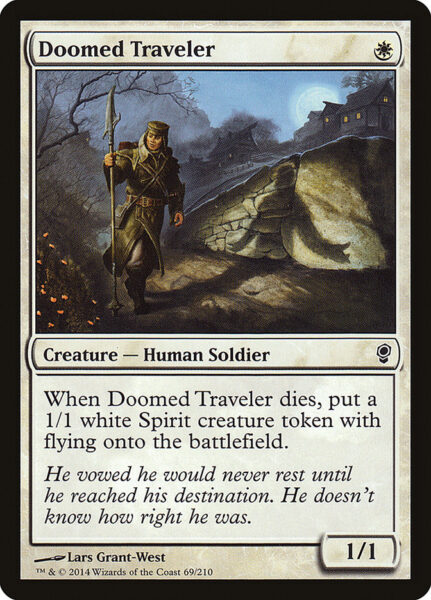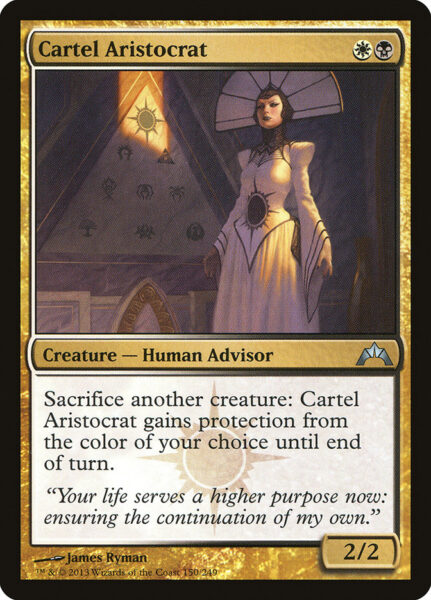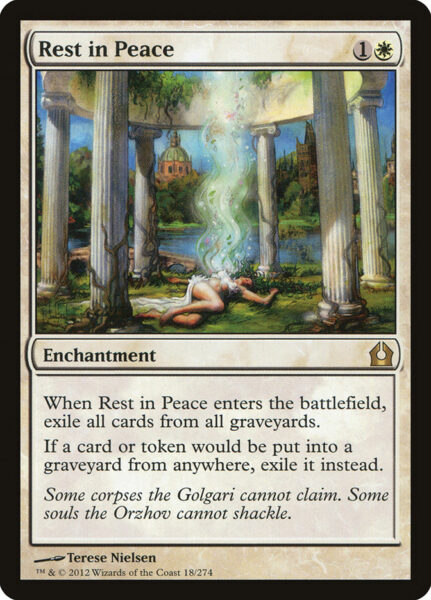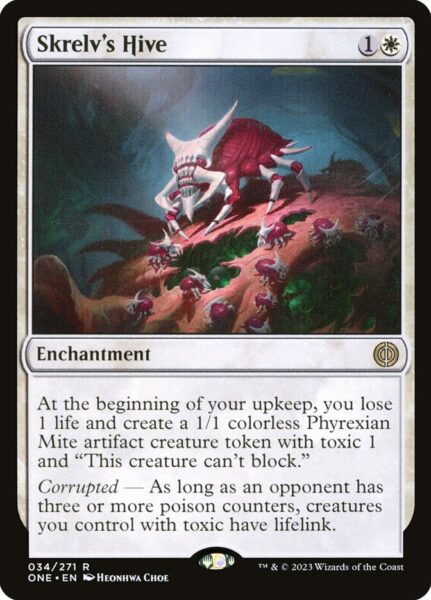by Johnny Cycles, July 18th, 2024
Hello! This is Johnny Cycles and welcome to my second edition of Pioneer Curious! After having so much fun with my Gruul Dragons deck in Pioneer, I couldn’t wait to try out one of my all-time favorite Standard archetypes – Aristocrats! Many of that deck’s best cards just missed the cut for Pioneer-legal sets, but power creep has seen some possible replacements. Will an archetype from the early 2010s be viable in the Pioneer of 2024? Let’s find out!
Decklist – Mardu Aristocrats
by Johnny Cycles
Format: Pioneer
Creatures (27)
| 4 Grim Initiate | |
| 4 Hunted Witness | |
| 4 Cartel Aristocrat | |
| 4 Cruel Celebrant | |
| 4 Zulaport Cutthroat | |
| 4 Butcher of the Horde | |
| 3 Ob Nixilis, Captive Kingpin |
Enchantments (7)
| 3 Impact Tremors | |
| 4 Fable of the Mirror-Breaker |
Instants (4)
| 4 Rally the Ancestors |
Lands (22)
4 Blood Crypt
1 Fabled Passage
4 Godless Shrine
2 Mountain
3 Plains
1 Raucous Theater
3 Sacred Foundry
1 Shadowy Backstreet
3 Swamp
Sideboard (15)
| 2 Abrade | |
| 2 Drannith Magistrate | |
| 3 Vanishing Verse | |
| 2 Aven Mindcensor | |
| 3 Tibalt, Rakish Instigator | |
| 3 Leyline of the Void |
The Aristocrat Archetype
The first competitive deck I played after returning to Magic in 2011 was Mardu Aristocrats, featuring the synergistic powerhouses Doomed Traveler, Skirsdag High Priest, Lingering Souls, and Blood Artist. The deck derives its name from Falkenrath Aristocrat and Cartel Aristocrat and refers to the style of play that wants to sacrifice one’s own creatures for value.
The goal was to flood the board with cheap creatures that would serve as fodder for our aristocrats to sacrifice in order to slowly drain our opponent out of the game or to make 5/5 flying Demon tokens (as early as turn 3) and beat face. The deck even ran the alternate win condition of Boros Reckoner and Blasphemous Act! In many ways, the Aristocrat archetype is a janky player’s dream. We get to play underpowered, fun, and flavorful cards that come together to do busted and powerful things.
Mardu Aristocrats in Pioneer
For an Aristocrat strategy to work, we need three essential parts. First, we want fodder for sacrifice. What made a card like Doomed Traveler so powerful in this archetype is the fact that it replaced itself. Lingering Souls gave us 4 tokens for a total of 5 mana. In Pioneer, we have Hunted Witness and Grim Initiate doing their best Doomed Traveler impression.
If only Doomed Traveler was legal in Pioneer…
I honestly don’t know which one of these cards is better…
What makes cards like Grim Initiate and Hunted Witness so powerful in our deck is that they give us two bodies to sacrifice. We don’t have any real token generation, short of Fable of the Mirror-Breaker, so getting a 2-for-1 out of our 1-drops is crucial to our success.
Second, we need a sacrifice outlet that gives us control of which creatures die and when.
Both of these cards are powerful in their own right. Cartel Aristocrat is tough to kill thanks to its protection. There will also be games in which its protection allows us to chip in just enough damage to close out a game. Every good Aristocrat deck needs a finisher and Butcher of the Horde is a strict upgrade to Falkenrath Aristocrat, in my mind. The lifelink is far from irrelevant, while haste gives us some sneaky reach. But what’s essential for the success of our deck is both creatures allow us to sacrifice other creatures with no tapping or mana investment.
A brief aside: Butcher of the Horde is one of the early examples of the power creep that began in the mid-2010s. Its from the same cycle of 3-color creatures as Mantis Rider and Siege Rhino. And while Wizards justified the increased power-to-mana-investment ration by the fact that you need 3 colors to cast these creatures, it wouldn’t be long before similarly powered-up creatures would begin appearing in 2- and 1-color creatures.
Finally, every Aristocrat deck needs a way of punishing our opponent for each creature sacrificed.
Blood Artist is the OG drainer of the Aristocrat archetype… Alas, it isn’t legal in Pioneer.
With just a couple of our Blood Artist effects on the battlefield, we can close out games extremely quickly. If we’re sacrificing our fodder to Butcher of the Horde, it is tough to lose.

Rally the Ancestors is the rug that ties the room together. We can win a variety of ways, but our most explosive, win-the-game-from-nowhere turns will be thanks to this card. For those of you unfamiliar with just how this looks, I manage to pull it off in game 2 of my first practice match below. Essentially, we want our three pieces detailed above on the battlefield so that we can sack everything to drain our opponent and gain a bunch of life. Then we cast Rally the Ancestors for and run it back. It’s a lot of fun.
The Spice
As mentioned above, every good Aristocrat deck needs a finisher. We can’t play Falkenrath Aristocrat, but there is no shortage of powerful 4-drops to take her place. I’ve chosen one of my favorites: Ob Nixilis, Captive Kingpin. His synergy with our Blood Artist effects make him a powerful finisher, as well as a card-draw engine.
Impact Tremors, meanwhile, synergizes with everything we’re trying to do. It grows Ob Nixilis, Captive Kingpin the turn we resolve him, while it also pings our opponent for each token we get from Hunted Witness and Grim Initiate, doubling up our damage in many situations. The real power, of course, is with Rally the Ancestors. Sacrificing everything for value AND bringing them back for value only to sacrifice them again for value is even more fun.
It’s possible Impact Tremors is a win-more card. I’m not in denial about that. However, it is super fun and I have a special place for it in my heart. Furthermore, it does increase our janky noncombat clock, while giving us a different way to punish our opponent, should they shut down our death triggers.
Sideboard
I’ve a little bit more experience now playing Pioneer, but I’m still sort of picking these 15 cards via trial-by-error.
Abrade and Vanishing Verse are meant to answer either creatures or graveyard hate our opponents bring in against us.
Leyline of the Void is for Arclight Phoenix and other graveyard-matters decks.
Aven Mindcensor and Tibalt, Rakish Instigator are for Amalia combo, though nerfing lifegain is important in other match-ups, as well.
Finally, Drannith Magistrate is for Niv-to-Light decks.
Weaknesses
Any deck that can nerf our death triggers or exile our creatures so that we can’t fill our graveyard are going to give us problems.
Combo decks that can ignore what we’re doing and win anyway can be faster than us.
Durdling is also a real possibility for us. Without all of our combo pieces, we can end up playing very underwhelming creatures while our opponent is resolving big bombs.
We don’t have much library manipulation or card draw, which may need to be addressed in the sideboard, so there will be games when we are really and truly at the mercy of the top of our deck. As you will see in the practice games, flooding or missing land drops is a reality that costs us several games.
Finally, we don’t play any removal in our main deck. I shudder every time I realize this, but I’m not yet ready to pull the trigger on Impact Tremors to make room for some kill spells.
I’ll discuss other directions for the deck in the wrap-up. For now, let’s get to the game play!
Practice Match 1 – Mono Red Panharmonicon
Practice Match 2 – U/W Control
Practice Match 3 vs. Turbo Fog
Practice Match 4 vs. Omnath Landfall
Practice Match 5 vs. Arclight Phoenix
Overall Practice Record: 3-2
A few things fluctuated between matches: the number of lands, the type of lands, and our sideboard choices. I went up to 22 lands and cut as many enter-the-battlefield tapped lands as possible. Dual lands like Concealed Courtyard are great options when they come in untapped, but they too often can cost us a game when we really need a 4th land to resolve Butcher of the Horde.
The sideboard, as mentioned above, is a work in progress, as it is with most any deck, I suppose. One thing that I’m trying out here that I don’t typically do is play 2 copies of a card. My normal approach to sideboarding is that if I want to see the card in games 2 and 3, then I should play at least 3 copies of it. We’ll see how it works out in our league games.
Overall, though, the deck was fun, sometimes explosive, and surprisingly resilient. If you’ve never played an Aristocrat deck, and even if you have, it can be hard to look at this pile of cards and see victory anywhere in our future. Nevertheless, we won on turn 5 more than once and more than one way. I’m not sure if that’s considered fast in Pioneer, but it seems pretty fast to me.
Rally the Ancestors was such a blowout, though we only got to see it a few times. Impact Tremors was a sneaky all-star, ensuring we chipped in damage to put us in range of lethal. Our strictly worse Doomed Travelers were very impressive. Butcher of the Horde is such a beater, hitting hard and oftentimes being a 10-point life swing.
Ob Nixilis, one of my favorite cards, even got to shine a bit. We never really got to go off in a way that let us take full advantage of the cards we exiled with him, but that was largely because it wasn’t necessary. We were winning without the extra cards or he was dying before we untapped.
Let’s see how it does in a league!
League Match 1 – Amalia Combo
https://www.youtube.com/watch?v=rXTdGCwrUy0
League Match 2 – Mono Green
League Match 3 – Niv to Light
League Match 4 – Amalia Combo
League Match 5 – Boros Prison
Overall Record: 1-4
League play was fairly brutal, though we had our one match win against Mono Green and not some tier 3 strategy, so there’s that. Amalia Combo, which we played twice, turned out to be simply too fast for us. We got a bit unlucky with our lands in some of the games against them, while they snagged our lifegain hate the turn before we were going to cast it in another. Niv to Light feels like a match-up we can win, and we did come close. However, the main-deck lifegain in some of their spells coupled with an inevitability in game 1 of refilling their hand makes it an uphill climb. And, they also play sweepers that exile creatures. Whew, it’s a tough world for the Aristocrat archetype.
Our last match was against a deck I’ve not seen before: Boros Prison. Those games weren’t even close. Their main deck is full of ways to interact with our strategy, thereby making it difficult to put together our pieces and win.
Overall, it was a pretty disheartening showing for Aristocrats. We lack card draw and library manipulation, which left us playing off the top of our deck more than our opponents seemed to be. Sure, we play a lot of 1- and 2-drops, but it often felt like we were out of cards to our opponent’s 4- or 5-card hand. I think this is due, in part, to the power creep that has made almost every constructed playable card do multiple things, including drawing cards. Given that we’re playing many cards from the mid 2010s, I wonder if we can improve our chances with some post-2020 cards.
Other Directions
I’m toying with a more token-heavy build of an Aristocrat deck, but I’m currently not happy with where it’s at. There have also been some powerful enablers printed since the early 2010s that I want to try out. Mondrak, Glory Dominus, Skrelv’s Hive, and Kambal, Profiteering Mayor are three cards I’m excited to build around. I also have an older version of Mardu Tokens with Young Pyromancer and Monastery Mentor that I’ll give a chance if able.
After our league, though, I wonder if we can’t do better than these changes. Or is the Aristocrat archetype a thing of the past? If we improve our card selection up the curve will we just end up with Rakdos Midrange? Let me know in the comments what you think of the deck and how you would change it to make it more competitive without losing its Aristocrat roots.
Conclusion
The best thing about this Aristocrat deck was how fun it was to play. With Modern essentially rotating with Modern Horizons 3, along with even more power creep for the rub-ins, Pioneer feels like a brewer’s dream. Sure, there are tier 1 decks that we’ll lose to more often than not, but the format has tons of room for innovation. And that means it has tons of room for fun. The free zone is full of decks looking to find a home in the format and some of our best and most fun games came there. League play can be a bit redundant, not to mention super challenging, but I’m not yet burnt out on the top decks, even if I’ve lost to them more than I’d like.
I may have to think of a new name for this column. I’m not Pioneer curious anymore…I’m Pioneer sold.
Thanks for reading and watching! I’ll catch y’all on the next one!




















